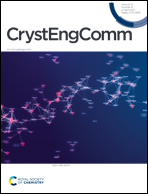Four anionic Ln-MOFs for remarkable separation of C2H2–CH4/CO2–CH4 and highly sensitive sensing of nitrobenzene†
Abstract
3-(3,5-Dicarboxylphenyl)-5-(4-carboxylphenyl)-1,2,4-triazole (H3DBPT) as a ligand was used to synthesize four porous anionic lanthanide-based metal–organic frameworks {[Me2NH2][Ln3L3(HCOO)]·7DMF}n (Ln-MOFs, Ln = Gd, Tb, Ho, Dy, L = H3DBPT) under solvothermal reaction conditions. Single-crystal X-ray diffraction reveals that the four Ln-MOFs are isostructural and belong to the monoclinic C2/m space group. Three Ln(III) ions are connected through ten carboxylic groups to form a trinuclear [Ln3(COO)10] SBU. The SBU polyhedra share edges with each other generating a 1D inorganic chain along the a-axis, and the chains are further connected by the L3− ligands to construct the final 3D framework with tunnels parallel to the a-axis. The luminescence intensity of the Tb-MOF can be modulated using small molecule organic solvents, and the Tb-MOF exhibits significant quenching in nitrobenzene, which indicates that the Tb-MOF is a potential luminescent sensing material for nitro explosives. Furthermore, the Gd-MOF after desolvation exhibits potential for industrially important C2H2/CH4 and CO2/CH4 separation. The highly selective adsorption of C2H2 and CO2 over CH4 might be attributed to the synergistic interplay of the tunnels, the functional active sites such as open metal sites and the Lewis basic nitrogen atoms on the tunnel surface.

- This article is part of the themed collection: Coordination Networks


 Please wait while we load your content...
Please wait while we load your content...